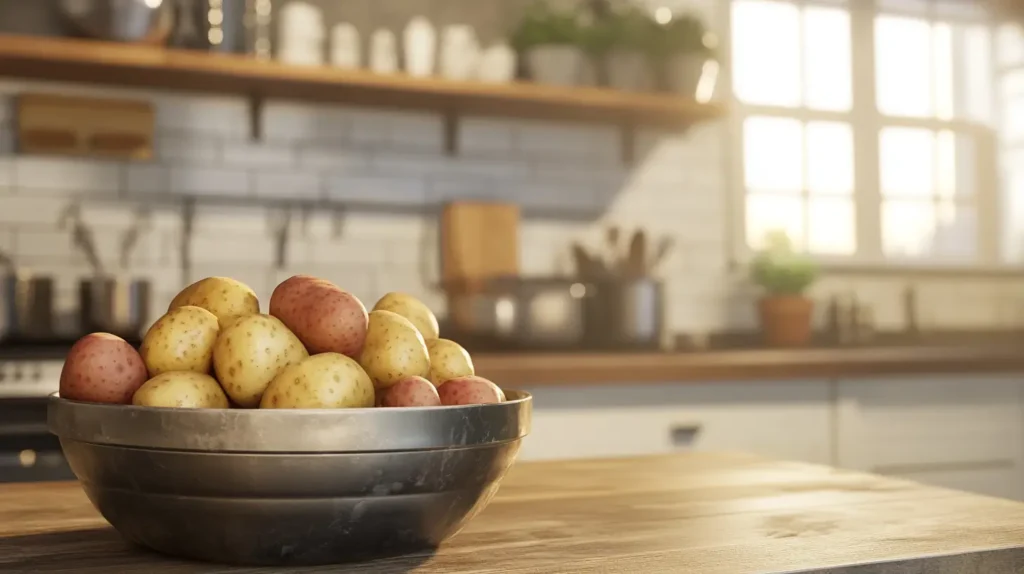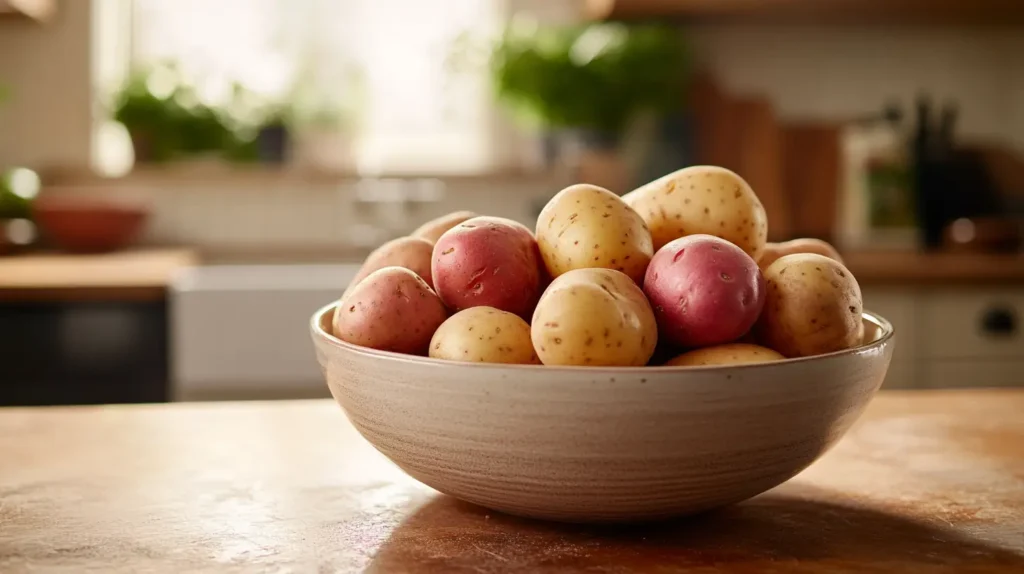How Long Do Potatoes Last at Room Temperature? Understanding the factors that affect their shelf life is crucial to avoiding spoilage and enjoying this versatile, nutritious ingredient for longer periods. Proper storage techniques can help extend the freshness of potatoes and ensure they last at room temperature.
In this article, we’ll explore the lifespan of raw and cooked potatoes at room temperature, the signs of spoilage, and practical tips for storing them correctly.
Table of Contents
Understanding Potato Lifespan
1. Factors That Influence How Long Potatoes Last at Room Temperature
Potatoes are a staple in many households due to their versatility and long shelf life. However, how long they last at room temperature depends on several factors, including the type of potato and the storage conditions. Let’s dive into the details.
Factors That Influence Potato Shelf Life
1. Type of Potato
Different potato varieties have varying storage requirements and longevity:
- Russet Potatoes: Their thick skin helps them last longer than most other types.
- Red and New Potatoes: Thinner skin makes them more susceptible to spoilage.
- Sweet Potatoes: While technically not potatoes, they require specific storage conditions and have a shorter shelf life. For tips specific to preserving sweet potatoes, check out How to Keep Sweet Potatoes Fresh.
2. Storage Conditions
Proper storage is essential to prolonging their usability:
- Temperature: Room temperature (60–70°F or 15–21°C) works for short-term storage, but cooler temperatures (45–50°F or 7–10°C) are best for longer periods.
- Humidity: High humidity can lead to sprouting or rotting, whereas dry conditions can cause them to shrivel.
- Light Exposure: Potatoes stored in light may develop green patches, producing a bitter taste and potentially toxic compounds. For more guidance on extending the storage life of potatoes, see Sweet Potatoes: Shelf Life and Storage Tips.
How to Identify Spoiled Potatoes
Spotting spoilage early can help reduce waste. Potatoes that are shriveled, sprouting excessively, or have developed green patches should be discarded. If you’re dealing with sweet potatoes, consider reviewing Signs of Spoiled Sweet Potatoes for more detailed guidance.
Using Potatoes in Recipes
Potatoes nearing the end of their shelf life can still be used in various recipes, such as soups or stews. For ideas on making the most of your potatoes, check out Best Thickeners for Potato Soup to incorporate them effectively into hearty meals.aking geographic location an important consideration for storage practices.
Shelf Life of Raw Potatoes
2. How Long Do Raw Potatoes Last at Room Temperature?
Raw potatoes have a finite shelf life, especially when stored at room temperature. Here’s a breakdown of what to expect:
At Room Temperature (60–70°F or 15–21°C)
When kept in a pantry or kitchen counter under average room temperature conditions:
- Duration: Raw potatoes typically last 1–2 weeks before starting to sprout, shrivel, or develop soft spots.
- Risks: Warmer environments can speed up spoilage, while exposure to light encourages sprouting and the formation of green patches.
In Optimal Storage Conditions (Cool, Dry, and Dark)
If stored properly in a cool, dry, and dark place, such as a basement or a dedicated pantry:
- Duration: Raw potatoes can last up to 2–3 months without significant degradation in quality.
- Additional Tips: Avoid washing potatoes before storage, as excess moisture can lead to rot.
Factors That Shorten Shelf Life
Certain conditions can cause raw potatoes to spoil more quickly, such as:
- Damaged Skin: Potatoes with cuts, bruises, or punctures are more susceptible to rot.
- Moisture Exposure: High humidity or condensation can lead to mold or decay.
- Contact with Onions: Onions release ethylene gas, which can speed up potato spoilage when stored nearby.

Cooked Potatoes’ Shelf Life
3. How Long Do Cooked Potatoes Last at Room Temperature?
Cooked potatoes have a much shorter shelf life compared to raw potatoes, especially when left out at room temperature. Improper storage can lead to foodborne illnesses, so it’s important to handle them carefully.
Safe Storage Times at Room Temperature
- According to food safety guidelines, cooked potatoes should not be left out at room temperature for more than 2 hours.
- After this time, bacteria such as Clostridium botulinum (which can cause botulism) and Bacillus cereus can begin to grow, especially if the potatoes are kept in a warm, moist environment.
Refrigeration for Longer Storage
To extend the lifespan of cooked potatoes:
- Refrigerate Promptly: Store cooked potatoes in an airtight container and place them in the refrigerator within two hours of cooking.
- Duration in Fridge: Properly stored cooked potatoes can last 3–5 days in the fridge.
Freezing Cooked Potatoes
Cooked potatoes can also be frozen for even longer storage:
- Steps to Freeze:
- Let the potatoes cool completely after cooking.
- Place them in freezer-safe bags or containers.
- Remove as much air as possible to prevent freezer burn.
- Duration in Freezer: Cooked potatoes can last 6–8 months in the freezer, though their texture may change slightly upon thawing.
Risks of Leaving Cooked Potatoes Out
Leaving cooked potatoes out for extended periods can result in:
- Bacterial Growth: Starchy foods like potatoes are highly susceptible to bacterial contamination, particularly when held in the “danger zone” temperature range of 40°F–140°F (4°C–60°C).
- Loss of Quality: Cooked potatoes left out too long will lose their texture, becoming soggy or rubbery.
Pro Tip for Meal Prepping with Potatoes
If you frequently prepare potatoes in bulk for meals, portion them into smaller, airtight containers after cooking. This makes reheating easier and reduces the risk of spoilage by preventing repeated temperature fluctuations.
Signs of Spoilage
4. Signs Potatoes Have Gone Bad After Storing at Room Temperature
Spotting early signs of spoilage helps ensure food safety and prevents waste. Here’s what to look for:
Spoilage Signs in Raw Potatoes
- Sprouting (Eyes):
Sprouts indicate aging but can be removed before cooking. However, discard potatoes if they are soft or shriveled alongside sprouting. For details on spoilage in sweet potatoes, refer to Signs of Spoiled Sweet Potatoes. - Green Skin or Spots:
Green patches form from light exposure and indicate increased solanine, which can cause a bitter taste and potential toxicity. If large portions are green, it’s best to discard the potato.
Spoilage Signs in Cooked Potatoes
- Slimy Texture:
A slimy or sticky coating on cooked potatoes suggests bacterial contamination. - Unpleasant Smell:
A sour or rancid odor is a clear sign of spoilage and warrants immediate disposal.
For further guidance on identifying spoilage, visit Spoiled Sweet Potatoes Guide.
Health Risks of Eating Spoiled Potatoes
Spoiled potatoes may harbor harmful bacteria or toxins, such as solanine, which can cause foodborne illnesses. Symptoms include nausea, vomiting, diarrhea, and abdominal cramps. Always discard potatoes that show clear signs of spoilage.
What to Do with Aging Potatoes
If your potatoes are showing signs of aging but are still safe to use, consider incorporating them into recipes like:
- Soups
- Mashed Potatoes
- Casseroles
For ideas, explore Best Thickeners for Potato Soup to make the most of your potatoes in comforting dishes.
Best Storage Practices
5. Tips to Extend the Shelf Life of Potatoes
Storing potatoes properly can significantly extend their usability and prevent unnecessary waste. Whether you’re dealing with raw or cooked potatoes, following these storage tips can help you maintain their freshness and quality.
How to Store Raw Potatoes
- Choose the Right Location:
- Store potatoes in a cool, dark, and well-ventilated place, such as a pantry, cellar, or cabinet.
- Avoid locations near heat sources like ovens or direct sunlight, as heat accelerates spoilage.
- Maintain Optimal Temperature:
- The ideal temperature for storing raw potatoes is 45–50°F (7–10°C).
- Storing them at room temperature (60–70°F or 15–21°C) is acceptable for short-term storage of up to 1–2 weeks.
How to Store Cooked Potatoes
- Cool Quickly Before Storing:
- After cooking, allow potatoes to cool to room temperature (within 2 hours).
- Avoid leaving them exposed for too long to prevent bacterial growth.
- Refrigerate in Airtight Containers:
- Place cooked potatoes in a tightly sealed container or use heavy-duty plastic wrap to keep out air and moisture.
- Store in the refrigerator, where they can last 3–5 days.
Common Storage Mistakes to Avoid
- Storing in the Refrigerator (Raw Potatoes):
- While refrigeration may seem like a good idea, raw potatoes develop a sweet taste and gritty texture at low temperatures due to starch converting into sugar.
- However, sweet potatoes can be refrigerated without similar issues.
- Stacking Too Many Potatoes Together:
- Crowded storage spaces can reduce airflow, leading to faster spoilage.
- Spread potatoes out or layer them lightly to allow ventilation.
Using Storage Accessories
Investing in simple storage accessories can help prolong potato freshness:
- Potato Storage Bins: Designed to block light and allow airflow.
- Breathable Bags: Reusable mesh or burlap bags are eco-friendly and prevent moisture buildup.
- Temperature-Controlled Storage Boxes: Ideal for maintaining consistent conditions in warmer climates.
Frequently Asked Questions (FAQs)
6. FAQs About Potato Storage
Q1: Can you store potatoes in the fridge?
- Answer:
While it may seem like refrigeration would extend the shelf life of potatoes, it’s not recommended for raw potatoes. The cold temperature converts the starch in potatoes into sugar, altering their flavor and texture. However, cooked potatoes can safely be stored in the refrigerator for up to 3–5 days.
Q2: Why do potatoes sprout, and are sprouted potatoes safe to eat?
- Answer:
Potatoes sprout when they are exposed to warmth or light, as these conditions encourage growth. While sprouted potatoes are technically still safe to eat, the sprouts and the areas around them contain solanine, a toxic compound. Always remove sprouts and any green spots before cooking. If the potato is soft or shriveled in addition to sprouting, discard it.
Q3: Are green potatoes dangerous to eat?
- Answer:
Yes, green potatoes can be dangerous due to high levels of solanine, a naturally occurring toxin. Consuming green potatoes in large amounts can cause nausea, headaches, or even more severe symptoms. If only a small area is green, you can cut it off. However, if the potato has turned green extensively, it’s best to discard it.
Q4: How do I prevent potatoes from sprouting?
- Answer:
To prevent sprouting:
- Store potatoes in a cool, dark, and dry place.
- Avoid storing them near ethylene-producing produce like onions and apples.
- Use breathable storage containers like mesh bags or baskets for ventilation.
Q5: Can I freeze raw potatoes?
- Answer:
Raw potatoes do not freeze well because their high water content causes them to become mushy when thawed. However, you can freeze potatoes after blanching (briefly boiling them) or cooking. Mashed, roasted, or baked potatoes freeze particularly well and retain their texture.
Conclusion
7. Summary: How Long Potatoes Last and How to Keep Them Fresh
Potatoes are a versatile and nutritious pantry staple, but their longevity depends on proper storage. At room temperature, raw potatoes can last 1–2 weeks, while cooked potatoes should not be left out for more than 2 hours. Storing them in a cool, dark, and dry environment can extend their freshness for up to 2–3 months. However, exposure to light, moisture, or heat can lead to spoilage, sprouting, or the formation of green spots.
For cooked potatoes, refrigeration is essential to maintain their quality for 3–5 days, and freezing can extend their usability for months. By following best practices—like using ventilated storage containers, separating them from ethylene-producing produce, and removing spoiled potatoes from the bunch—you can ensure they stay fresh and safe to eat for as long as possible.
Key Takeaways
- Storage Tips for Raw Potatoes: Keep them in a cool, dark, and well-ventilated space to maximize their shelf life.
- Handling Cooked Potatoes: Refrigerate promptly and store in airtight containers to prevent bacterial growth.
- Spoilage Awareness: Be vigilant for signs like sprouting, green patches, foul odors, or soft textures.
- Extend Shelf Life: Use methods like blanching and freezing for long-term storage, especially for cooked potatoes.


